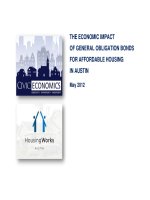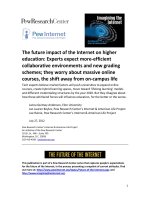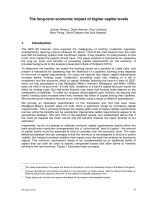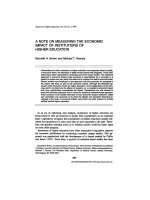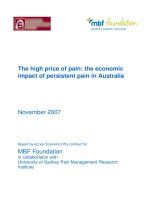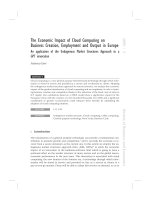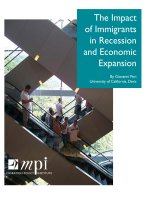Economic Impact of Investment in Public Higher Education in Massachusetts: Short-Run Employment Stimulus, Long-Run Public Returns docx
Bạn đang xem bản rút gọn của tài liệu. Xem và tải ngay bản đầy đủ của tài liệu tại đây (356.16 KB, 44 trang )
Economic Impact of Investment
in Public Higher Education
in Massachusetts:
Short-Run Employment Stimulus,
Long-Run Public Returns
Michael Ash, Ph.D.
Professor of Economics and Public Policy
Department of Economics and
Center for Public Policy and Administration
University of Massachusetts Amherst
Shantel Palacio, MPPA
Center for Public Policy and Administration
University of Massachusetts Amherst
April 2012
TABLE OF CONTENTS
SUMMARY
1
1. IMMEDIATE JOB-CREATION
▪ Quantitative methods used in analyzing short-term effects
▪ Elements of the stimulus
▪ Spending/investment choices for the commonwealth
▪ What the data show about short-term benefits
Table 1. Jobs created by $800 million expenditure
Table 2. Quality of employment indicators, direct-effect industries
Table 3. Balanced Budget Higher Education Investment Program
Massachusetts employment effect of increasing taxes and higher
education investment by $800 million
2. LONG-TERM INCREASES IN TAX REVENUES AND OTHER GAINS
Table 4. Impact of higher education investment on annual earnings and
tax revenue for Massachusetts
Table 5. Estimated Lifetime State and Local Taxes Across Education
Categories in Massachusetts, 2010
3. REDUCTION IN OTHER AREAS OF STATE SPENDING
Table 6. Lifetime State and Local Expenditures Across Education
Categories in Massachusetts
Table 7. Estimated Lifetime Fiscal Effects per Four-Year Equivalent
Degree in Massachusetts
▪ Higher education in the current economy
4. BROADER SOCIAL AND ECONOMIC BENEFITS
▪ Advantages of greater access to higher education for all
▪ Public spending is key to attracting students
2
3
5
7
8
9
12
14
15
17
18
20
21
23
24
25
29
31
Table 8. Estimated enrollment, expenditure, and tuition impact of $800
million public higher education investment program (PHEIP)
33
▪ Higher education and long-term commitment to Massachusetts residents 34
CONCLUSIONS
Bibliography
35
37
Prepared with a grant from
Massachusetts Society of Professors (MSP)
Acknowledgments. We thank Zachary Phillis for excellent research assistance, Ferd Wulkan
and John Stifler for editing, and Benjamin Taylor for public relations. We thank the advisory
board for the project for guidance and comments: Professor Robert Pollin (Political Economy
Research Institute and Department of Economics) and Professor Nancy Folbre (Department
of Economics) both of the University of Massachusetts Amherst. We thank Philip Trostel
(University of Maine) for comments and methodological contributions.
SUMMARY
Extensive economic evidence makes it clear that increased state spending on public higher
education in Massachusetts should be a top priority now and for the foreseeable future. This
conclusion follows from an analysis of the economic impact of such spending, based on new
research by economists measuring the quantitative relationships between the circulation of
money, the overall health of a society, and the position of higher education in that relationship.
In this report we examine both the short-run employment impact of additional spending on
higher education and the long-run financial impact of investing in a better-educated workforce.
The conclusions, which can be summarized in four main categories, are encouraging:
1.
Increasing public funding of public higher education in Massachusetts will create an
immediate increase in the number of jobs in the state, more than alternative uses of the
same funds will create.
2.
It will continue to improve employment in the long run, through the increased tax
revenue that results from more and better employment across the Commonwealth.
3.
The long-run benefits will include a reduction in demand on spending for welfare and
other social programs
4.
By increasing material benefits to individual citizens and families, increased public
funding of public higher education will also create broader social and economic benefits.
Government officials, business leaders, and citizens’ groups are all seeking ways to expand the
Massachusetts economy. These new findings make it clear that compared to commonly
considered alternatives, increased public funding for the state’s institutions of higher education is
the most robust, efficient and viable, ensuring the greatest short- and long-term benefits. A
[1]
systematic analysis of current data indicates that while the present cost of educating someone in
a public institution of higher education in Massachusetts is slightly over $49,000, that public
college or university graduate will in return, by even the most conservative estimates, contribute
a net of more than $98,000 to the state after college. This graduate will pay more taxes, since his
or her income will be higher, and will put less of a burden on public services. In other words, for
every additional student educated in a public college or university in the state, the
Commonwealth of Massachusetts comes out nearly $50,000 ahead. No other use of a
comparable outlay of public funds can match this one in terms of how it repays the investment.
Thus, at the most basic dollars-and-cents level, increased public funding for public higher
education eminently justifies itself and provides increased benefits for the entire Commonwealth.
1. IMMEDIATE JOB-CREATION
In the short run, spending on public higher education will create relatively high-paying jobs, and
workers will recirculate the earnings from those jobs. Such a stimulative effect for the state’s
economy is analogous to what can often be accomplished by private investment, but the
differences are significant, especially in terms of how efficiently the public investment can
deliver benefits to the largest number of citizens and to the Commonwealth as a whole. In
particular right now, increased spending on public higher education in Massachusetts will
reinvigorate the Massachusetts economy by creating jobs in sectors that have suffered in the
current downturn. One obvious area is construction work; others include service jobs
(maintenance, food preparation, security) and professional work (architects, planners, etc.).
Standard economic analysis shows a definite, positive short-run impact on employment in
Massachusetts. To make this short-run analysis meaningful, we compare the impact of additional
[2]
public spending on higher education with the impact of equivalent public spending on other
kinds of economic activity, including casinos, health-care, and tax cuts. We have focused on
how these different kinds of additional public spending can boost employment.
Quantitative methods used in analyzing short-term effects
Our conclusions about the strongly positive short-term job-creation effect of increased public
funding for higher education in Massachusetts are based on a method known in economics as
Input-Output analysis. Its application is described in a 2009 study by Robert Pollin and Heidi
Garrett-Peltier, of the Political Economy Research Institute at the University of Massachusetts
(Pollin and Garrett-Peltier 2009). This method makes it possible to compare the short-run effect
on employment that results from spending on public higher education to the effects resulting
from other kinds of public and private spending. The main data sources for this component of
the analysis are the Input-Output tables developed by the U.S. Bureau of Economic Analysis
(BEA). These tables show data from surveys of households and firms that generate estimates
specific to Massachusetts, thereby enabling policy makers to apply results from the broader
literature of economics to the specific context of the Massachusetts economy.
Calculating the employment impact of an expenditure on a given activity means counting three
effects of that expenditure: direct, indirect, and induced. The direct effect of the expenditure is
that it pays for the activity itself, buying goods and services from a range of suppliers. Its
indirect effect consists of the further economic activity it stimulates among those suppliers, since
they in turn require goods and services from other suppliers. For example, an accounting firm,
hired as part of the direct effect of the expenditure, requires paper and ink from stationers and
electrical energy from power generators. Those purchases by the accounting firm are indirect
[3]
effects of the initial expenditure. Finally, the workers and owners of both the directly affected
activity and the indirectly affected suppliers now receive additional income, which they spend on
a variety of consumer goods and services. This additional expenditure is induced by the initial
spending on the direct activity, and it too stimulates additional economic activity and
employment. The employment generated by the direct, indirect, and induced pathways is the
total employment effect of the stimulus.
In economics terminology, the goods and services purchased are inputs; the goods and services
produced from these inputs are outputs. For a contractor, a bulldozer is an input, a building’s
foundation is an output. For a university, buildings and faculty are inputs; educated graduates,
whose subsequent work is of value to the economy, are outputs. Input-output analysis that will
identify the employment impacts of various spending choices is based on a set of tables for the
U.S. economy with data produced by the BEA, as well as on interfaces provided by several
private, independent economic analysis firms. In this report, the basis of the employment-impact
estimates is IMPLAN, a reliable and widely used commercial product that analyzes dollar-figure
expenditures in terms of the value of what those expenditures produce.
In such a short-run analysis, it is useful but incomplete to speak of the employment impact of a
particular expenditure. As Siegfried et al. (2006) and Pollin and Garret-Peltier (2009) observe,
such an approach fails to consider the alternative effects that would be obtained with a different
use of the same resources – people, money, etc. If public higher education funds were put to an
alternative use, these funds would still generate employment (output), and the employees and
owners of the alternative activity would receive compensation and profits, which they would
spend on a range of consumer goods. The crucial question is which kind of expenditure will
[4]
produce the greatest gain. The analysis in this report considers the alternatives and so
determines the employment impact of expenditure on higher education relative to the effects of
other kinds of spending.1
Elements of the stimulus
The employment effect of an economic stimulus depends on three factors: the size of the
stimulus; the labor intensiveness (how many people it employs for what it accomplishes) of the
activity it funds; and average compensation (wages and benefits). For an analysis in a particular
geographic region, especially in a relatively small state such as Massachusetts, a fourth factor
bears on the local employment impact, a factor referred to here as leakage. To the extent that the
employment effects in distant locations -- literally from New Hampshire to China -- are not of
interest to Massachusetts public decision-makers, anyone trying to determine the local
employment effect of a policy in Massachusetts needs to adjust the analysis by not counting the
portion of the stimulus taking place beyond the state’s borders. The input-output method
implemented by IMPLAN makes it possible to account for such leakage.
One feature of input-output analysis is that the source of the money to be spent does not matter
in assessing its impact on employment. In terms of the immediate employment impact of
additional expenditure on public higher education, it makes no difference whether the additional
1
In 2006, also using an input-output analysis, the Office of the President of the University of
Massachusetts reported the annual Massachusetts employment effect for the UMass system to be
29,000 jobs, of which 15,000 were direct employment by UMass and an additional 14,000 jobs were
stimulated through the indirect effect on contractors and other suppliers (UMass Office of the President
2006). As noted above, however, this analysis is incomplete since it does not compare employment
effects of alternative expenditures.
[5]
expenditure comes from public sources -- a higher state budget appropriation for the public
college and university systems -- or from private sources, primarily students’ or student
families’ tuition payments. However, we are presuming – and we are convinced that the
Commonwealth in general can safely presume – that a still larger share of the cost of higher
education cannot efficiently be borne by the average student’s family, let alone by poorer
households. In 2010, average tuition and fees at Massachusetts’s public four-year institutions
were 30% above the national average; at public two-year institutions they were 52% above the
national average (Chronicle of Higher Education 2010). Even before the recession of 20082010, student debt upon graduation had become high enough to compromise the new graduate’s
options either for employment or for further study, and to maintain an uncomfortably high debt
burden on a growing number of Massachusetts families. We return to the issue of high tuition
and fees of higher education in the final sections of the study.
In determining the best allocation of new expenditures, three areas are particularly relevant for
comparison to higher education: casino construction and operation, health care spending, and
income tax reduction. Spending could be directed towards other public priorities, but the three
alternatives listed above are the most useful points of comparison because they are currently
policy-relevant and because the level of expenditure in each is similar to the level of expenditure
on public higher education – in the current state budget, roughly one billion dollars per year.2
Policy-makers need to be concerned not only with the number of jobs created but with the type
2
The 2001 reduction of the Massachusetts personal income tax rate by 0.65 percentage points accounts
for approximately 1 billion dollars per year in foregone revenue. Casino gambling is forecast to
produce revenue of between $750 million and $1.5 billion per year (Massachusetts Statewide Gaming
Report 2010).
[6]
and quality of these jobs. In comparing alternative expenditures, this analysis therefore estimates
the wage distribution of jobs created by each spending priority, i.e., how many new jobs will
there be, how well are they paid, and how much difference will there be between the highest and
lowest salaries or wages in these various sectors of employment? In addition, the analysis of
public higher education spending in Massachusetts must account for both in-state spending and
out-of-state leakage.
Spending/investment choices for the commonwealth
Before comparing specific spending programs, we consider the broader goal of a spending
increase. Each year the State computes a revenue gap for public higher education – the amount
by which the revenue available to Massachusetts institutions of public higher education falls
short of the amount needed to maintain these institutions’ focus, mission, and enrollment, based
on their locations and facilities. It establishes dollar values by using national standards, peer
comparisons, and fundamental quality targets. The Massachusetts FY2011 budget request by the
State Board of Higher Education observes that the revenue gap for the state university and
community college system, i.e., not including the UMass system, is now approximately $440
million. Since the UMass system accounts for nearly half of all state expenditure on higher
education, a reasonable estimate for the full gap is $800 million.
The state can invest in public higher education in several ways. For example, it might make an
extensive capital investment by constructing new buildings, or it could expand faculties and staff
while continuing to use existing facilities. Different investment programs will have different
impacts on employment depending on the employment profile of the component activities. This
report examines two public higher-education spending alternatives, one involving new
[7]
construction, the other assuming all the funds are used to expand educational activity in existing
facilities. Each involves a single, substantial increase in the public higher-education budget,
which will then be maintained at this new, higher level in subsequent years.3
In each scenario, we consider the impact of an $800 million increase in the annual higher
education budget. In the first scenario, in the initial two years half the money is spent on new
construction, half on expansion of existing educational activity; in following years, the full $800million increase is applied to expanded educational activity. In the second scenario, we consider
simply spending the proposed $800 million on the expansion of existing educational activity,
without any investment in construction.
What the data show about short-term benefits
Table 1 displays the employment effect of various uses of an $800 million outlay. The first five
rows of the table consider $800 million of additional spending; the other four rows show the
effects of four different $800 million income-tax cuts. For higher education, the table shows the
numbers for the two scenarios described above: a 50-50 mix of construction/maintenance and
operating expenses, or a 100 percent expenditure on operating expenses. For casinos, which
have been embraced for their job-creation potential in Massachusetts, similar scenarios are
examined: a 50-50 mix of construction and operation, or purely operation. For health care, our
analysis considers using the $800 million entirely for expanding ongoing services.
3
This level will subsequently be adjusted only for inflation and population increase.
[8]
Table 1: Jobs created by $800 million expenditure
Direct
Effect
Indirect
Effect
Sum: Direct
and Induced
Effects
Induced
Effect
Total
Jobs
In spending
Higher Education (construction/operating)
Higher Education (operating)
7,252
8,861
1,471
1,420
8,723
10,281
3,042
3,189
11,766
13,470
Casino (construction/operation)
Casino (operation)
5,535
6,505
2,338
3,062
7,873
9,568
2,603
2,706
10,476
12,274
Health
5,774
1,507
7,281
3,309
10,590
5,124
5,186
5,303
5,342
5,124
5,186
5,303
5,342
In Tax Cuts
Household income >$150K
Household income> $50K
Household income>$35K
All households
Notes
Source: IMPLAN and author's calculations.
Following these spending scenarios, we consider four different $800 million tax cuts. The first is
a tax cut accruing largely to households with incomes in excess of $150,000 per year, the group
that benefited most from the reduction in 2001 of the tax rate on dividends and capital gains from
12 percent to 5.3 percent. The second and third scenarios examine $800 million in tax cuts that
accrue to households with earnings over $50,000 or $35,000 respectively. The final scenario
would distribute the tax cuts on an equal per-household basis, even to households with no
existing income-tax liability.
For the spending scenarios, the employment effect is divided into three components: the direct
effect of the spending on the sector in which the spending occurs, the indirect effect as the target
[9]
sector then purchases inputs from Massachusetts businesses, and the induced effect as the
recipients of the new wage and profit income spend some of this income on household
consumption. For the tax-cut scenarios, because no industry receives the initial demand
stimulus, there is neither a direct effect nor an indirect effect. The tax cut increases the disposable
income of households, who choose to spend some of this income on Massachusetts-produced
goods and services. The rest of the addition to disposable income is saved or is spent on goods
and services from out-of-state; the employment created by the spending on Massachusettsproduced goods and services is the induced effect. In each scenario, the analysis examines the
one-year employment effect of a year of spending. If the additional spending continues, i.e., if
the $800 million additional spending becomes a permanent part of the budget, then the
employment will continue.
In each of years one and two, the expenditure on higher education and construction generates
7,252 jobs through the direct employment effect, an additional 1,471 jobs at in-state suppliers,
and a further 3,042 jobs as households spend their new earnings. The total number of jobs
created is 11,766. In subsequent years, the direct employment effect increases to 8,861, in large
part because higher education is more labor-intensive than construction. The indirect, or
supplier, effect contributes an additional 1,420 jobs, and higher household expenditure adds
another 3,189. The total number of jobs created is 13,470. The increase in employment for $800
million in casino spending is somewhat lower, ranging from 10,476 to 12,274 jobs; for health
expenditure it is lower still, at 10,590.
The employment effect of tax cuts is substantially lower -- between 5,124 and 5,342 new jobs
depending on how the tax cut is structured. Because of the spending and, more particularly, the
[10]
saving patterns of higher-income households, the tax cuts directed to higher-income households
produce less employment than those directed to lower-income households. This variation among
the effects of alternative tax cuts, however, is overwhelmed by their substantially less stimulative
effect on Massachusetts employment regardless of which approach to tax-cutting is taken. The
basic reasons for the low impact of tax cuts are, first, that households spend only part of a tax
cut, while saving the rest; second, that household purchases do not necessarily stimulate
employment in the state; and, third, that while the induced effect of tax cuts is greater than the
induced effect of investment in higher education, casinos, or healthcare, investments in these
areas also generate direct and indirect effects, making the total effect in those areas greater than
in any of the tax cut scenarios.
Table 2 shows the average wage and the range of wages in the direct employment sectors for
each expenditure area -- two figures that are reliable means for assessing the quality of the jobs
created. A higher average wage and a low spread from low to high indicate that expenditure in
these sectors will create better jobs than an alternative choice would create. The smaller spread
between the highest- and lowest-paying jobs indicates that any given job in this area is more
likely to be a desirable one, since even the lowest-paying jobs in this sector pay relatively well.
At the same time, other things being equal, a higher average wage indicates that fewer jobs may
be created per dollar of expenditure. This relationship, however, is not automatic and invariable,
because some sectors may be more labor-intensive, employing more workers and less expensive
plant equipment. Table 2 also shows the unemployment rate in each direct-expenditure sector
under analysis.
[11]
Table 2: Quality of employment indicators, direct-effect industries
Average
annual wage
Higher Education
Construction
Casinos
Health (non-MD)
$39,313
$41,214
$27,760
$36,160
Range of Occupational Average Wages
low
teaching
assistants
laborers
dealers
cleaners
Unemployment
(%)
high
$22,700
$29,490
$16,310
$18,420
faculty
managers
managers
RN's
$61,500
$81,870
$68,290
$61,420
4.1
20.6
11.8
4.9
Notes
Average annual wage is the employment-weighted average of the median wage in the BLS sub-occupations
for the United States, 2008-2009.
Unemployment is national unemployment rate, 2010.
Source: Bureau of Labor Statistics and author's calculations.
Average annual earnings in higher education are $39,313 per year. In construction, which is part
of one of the higher education programs and one of the casino expenditure programs considered
here, average annual earnings are $41,214. In casinos, average annual earnings are $27,760 per
year; in health care, not including MD’s, the average is $36,160 per year. Other relevant features
of desirable jobs include health insurance coverage, pension coverage, and other non-wage
benefits; the size of these benefits varies substantially across sectors. For example, access to
medical coverage is available to 70 percent of workers in construction, 83 percent of workers in
installation, maintenance and repair, 90 percent of workers in public education, and only 44
percent of workers in services (Bureau of Labor Statistics)
In higher education, the lowest paid category of employees are teaching assistants, typically
graduate students who teach to support their own post-baccalaureate education; their average
annual earnings are $22,700 per year. At the high end, faculty earn on average $61,500 per year
[12]
across a range of disciplines and levels of institutions. In construction, the range of earnings is
significantly wider, from laborers who earn $29,490 per year to managers with average annual
earnings of over $80,000. (Again, we keep in mind that while the low end of this range is higher
than it is for higher education, the lowest paid people in higher education are graduate students
on their way to more lucrative careers, and that the average salary in construction is still lower
than it is in education.) The range in the casino industry and in health care is wide, from average
earnings well below $20,000 in the lowest paid job categories to earnings for the highest-paid
workers in excess of $60,000.
This analysis of the quantity and quality of employment in jobs created by investment in higher
education answers the charge of Siegfried et al. (see p. 5) to consider alternative expenditures.
The comparison to casino expenditure and to health care expenditure indicates that higher
education is a cost-effective way to create additional jobs, with more jobs created per dollar of
expenditure than in these other sectors. Furthermore, the jobs created are of generally high
quality, with average annual earnings of $40,000 per year, a relatively narrow salary range and
low unemployment (4 percent nationally for all persons employed in higher education in 2010);
in other words, these are stable middle-class jobs.
While Tables 1 and 2 describe the quality and quantity of jobs created under alternative programs of
spending, they do not consider the source of spending. Assuming the new funds for higher education
come as a result of a tax increase, we must examine and factor in to what extent a tax increase will reduce
household expenditure, in turn reducing demand for some kinds of goods and services. Thus, the
employment gain from new investment in higher education (or casinos or health care) must be
adjusted to include the loss of employment resulting from lower household expenditures caused
by a tax increase.
[13]
In this analysis, the $800 million increase in spending on higher education is funded by a tax
increase that would affect only households earnings more than $50,000 per year. As shown in
Table 3, these higher taxes correspond to a decrease in employment of 5,186 jobs -- less than half
the number of new jobs simultaneously created. The net employment effect from increased
public spending on public higher education is therefore overwhelmingly positive. As indicated
in the last row, Net Employment Effect, the higher education investment program creates 6,580
net new jobs in Massachusetts, increasing to 8,284 in subsequent years. Furthermore, in the first
two years of the program a significant share of the employment will be in construction, an area
that has been highly depressed, with a national unemployment rate of more than 20 percent (see
last column of Table 2). These high-quality jobs are fully paid for, and they put people in the
Commonwealth to work by using existing resources.
Table 3: Balanced Budget Higher Education Investment Program
Massachusetts employment effect of increasing taxes and higher
education investment by $800 million
Employment Effect (Change in Jobs)
Years 1-2
Year 3 and beyond
Direct Employment (Higher Education)
Indirect Employment (Suppliers)
Induced Employment (Earnings)
H.E. Total Employment Effect
7,252
1,471
3,042
11,766
8,861
1,420
3,189
13,470
Taxes
-5,186
-5,186
6,580
8,284
Net Employment Effect
Notes
Higher Education Investment Program
Years 1-2 assume higher education investment split between the expansion of activity
at existing facilities and new public construction.
Year 3 and beyond assumes the full higher education investment in expansion of activity
at existing and new facilities
Tax Program
Investment in higher education is financed by an income-tax increase affecting only
households with income greater than $50,000
Source: IMPLAN and author's calculations
[14]
As of December 2011, the unemployment rate in Massachusetts was 6.8 percent; during the
decade that ended with the December 2007 business cycle peak, it had averaged 4.5 percent. The
difference represents a shortfall of some 80,000 new jobs. That is, the Commonwealth of
Massachusetts needs approximately 80,000 new jobs to return the unemployment rate to 4.5
percent. The net increase of approximately 8,000 new jobs from a balanced-budget highereducation investment could represent an important share of the needed increase. In technical
terms, the net increase in employment is larger than the opportunity cost – i.e., it is larger than it
would be in any of the alternative spending or tax-cutting scenarios – and therefore the decision
to fund the expansion of higher education with public funds is the right one.
2. LONG-TERM INCREASES IN TAX REVENUES AND OTHER GAINS
As the previous section shows, higher education investment is an excellent job-creator.
Moreover, the employment generated by the higher education investment program is far more
than any dig-a-hole-and-fill-it-up employment stimulus. Higher education investment builds
both human capital -- the health, know-how, and other productive capacity of the population -and social capital, i.e., the networks and relationships among people that magnify their
productivity exponentially. Both kinds of capital will pay long-run economic, fiscal, and social
dividends. In plainer terms, both mean more jobs, better jobs, increased tax revenues, a higher
quality of life, and a healthier economy. People with more education receive higher incomes,
accumulate greater wealth, and therefore generate higher tax revenues.
The following data analysis shows in specific terms how such an investment improves the
overall economic outlook for the Commonwealth. All the estimates are based on current, crosssectional differences between college-educated and high-school-educated workers. Their
[15]
usefulness as a guide to policy therefore depends on these differences’ remaining constant; if the
differences tend to fluctuate over time, policy analysts will need to make appropriate
adjustments. For instance, if the unemployment rate among college-educated workers were to
increase relative to that of less-educated workers, then the earnings premium and the publicexpenditure advantage would understandably be diminished. On the other hand, if the relative
labor market performance of college-educated workers increases – i.e., if they become more and
more likely to be well employed -- then the net benefits of higher education will prove larger
than presented.
Economist Philip Trostel (2007) converts data on the earnings differences among workers with
different levels of education into resulting differences in tax payments, which are the public’s
most visible return on its investment in public higher education. Trostel also examines
differences in subsequent public expenditure as a function of the level of education of the
recipient of the expenditure. He finds that college graduates are substantially less likely to draw
on a variety of public and social insurance programs than are people without college degrees.
Welfare, Medicaid and other public health care, Unemployment Compensation, or Worker’s
Compensation – a college graduate is statistically much less likely to require funds from these
sources than is someone with only a high school diploma. College graduates are also less likely
to be unemployed or in jail.
Key results for Massachusetts using Trostel’s methodology are shown in Tables 4-6, updated
with the most current data from the U.S. Current Population Survey. Table 4 shows the higher
average earnings for college-educated workers relative to those for workers with only high
school diplomas. The first row shows the level of annual wage and salary earnings by the level
[16]
of education. The second row shows the earnings differential for people with some college,
those with associate’s degrees, and those with bachelor’s degrees, relative to those who are only
high-school educated. As the numbers indicate, this degree premium expands sharply with the
completion of the bachelor’s degree. People with bachelor’s degrees earn, on average, more than
$30,000/year above what people with only a high-school diploma earn; more simply, the average
four-year college graduate earns twice as much as the average high school graduate.
Table 4. Impact of higher education investment on annual earnings and
tax revenue for Massachusetts
Average annual labor earnings and state and local tax revenues, 2010.
Some
Associate's
High
College
Degree
School
$31,162
$39,546
Wage and Salary Earnings
$26,029
Degree Premium
$5,133
$13,517
State Income Tax
$1,063
$1,630
$1,960
S.I.T. Premium
$567
$897
S.I.T. and Property Tax
$2,639
$3,561
$3,928
S.I.T. and Property Tax Premium
$922
$1,289
Bachelor's
Degree
$55,509
$29,480
$2,961
$1,899
$5,309
$2,670
Source: Annual Social and Economic Supplement of Current Population Survey 2009-2011.
Table 4 then shows the annual tax revenue differential between high-school educated workers
and those with some higher education or a post-secondary degree. As the table indicates, state
income tax and local property taxes paid each year by workers with bachelor’s degrees are
$2,670 greater than the taxes paid by workers with only high school diplomas. The state sales
tax adds modestly to the tax revenue advantage for workers with higher education. The sales tax
estimate used in Table 5 is taken directly from Trostel's estimates for 2005 and updated only for
inflation.
Table 5 shows the total average tax payment and the tax-revenue differential for the college[17]
educated over the taxpayer’s entire working life after graduation. Numbers in the table
distinguish between the Sum, which simply adds the amounts paid in taxes over the course of the
worker’s career, and the Present Value, a standard financial adjustment that puts more weight on
costs incurred and benefits realized today and less weight on costs and benefits realized in the
future.
Table 5. Estimated Lifetime State and Local Taxes Across Education
Categories in Massachusetts, 2010
High School
State Income Tax
Sum
Present Value
Degree Premium – Sum
Degree Premium – PV
S.I.T. and Property Tax
Sum
Present Value
Degree Premium – Sum
Degree Premium – PV
S.I.T., Property Tax, and Sales Tax
Sum
Present Value
Degree Premium – Sum
Degree Premium – PV
Associate's
Degree
Bachelor's
Degree
$42,511
$24,566
$78,384
$45,296
$35,873
$20,730
$118,451
$68,449
$75,940
$43,883
$105,552
$60,995
$157,107
$90,787
$51,555
$29,792
$212,356
$122,714
$106,805
$61,719
$151,681
$84,538
$210,667
$117,472
$58,987
$32,934
$283,386
$155,799
$131,705
$71,261
Present Values are calculated with a 3 percent real interest rate.
Source: Annual Social and Economic Supplement of Current Population
Survey 2009-2011 and Trostel (2007).
The logic of Present Value is that people are to some extent impatient and discount the future
relative to the present. The Present Value computation allows for this sentiment by means of a
[18]
standard formula familiar to accountants.4 However, a long-lived public entity such as our
Commonwealth, which has responsibility to future generations as well as to our own, might well
focus on the simple Sum, over time of benefits, minus costs. Both approaches are legitimate for
comparing the benefits and costs of college attendance, and so both are presented here.
For an illustration of advantages of investing public funds in higher education, in Row 1 we find
that a worker with a high school diploma pays Massachusetts $42,511 in state income tax over
the course of a career, while a worker with a bachelor’s degree, and therefore on average a much
higher income, pays $118,451 in state income tax – an additional $75,940, or almost three times
as much -- over the course of a career. However, because workers with the bachelor’s degrees
usually do their highest earning late in their careers, and because their earnings begin only after
four years of college, the Present Value of a college graduate’s additional tax payments is
$43,883.
The additional rows of the table show the degree premium for tax revenues paid in combined
income and property taxes (because college-educated workers own higher-valued homes) and in
these taxes plus sales taxes (because college-educated workers purchase more goods on which
sales tax is charged in Massachusetts). When income, property, and sales taxes are added, the
college-educated Massachusetts resident pays on average $131,705 more in Sum, or $71,261
more in Present Value, in state and local taxes than does someone with only a high school
4
Each year's term in the Sum is divided by (1.03)t, where .03 is the currently standard assumed discount
rate for public sector applications, and t is the number of years in the future that the cost or benefit
arrives.
[19]
education. The additional tax revenue alone covers the cost per public degree, without any
consideration of the effect on public expenditure or the non-monetary social value of a collegeeducated work force. When these two factors are included in the calculation, the net gain for the
Commonwealth is significant.
3. REDUCTION IN OTHER AREAS OF STATE SPENDING
Beyond the fact that some of the benefit created by public investment returns directly to the
public coffers in the form of higher tax revenues from those with associate’s, bachelor’s and
advanced degrees, more highly educated people also require less in the way of public
expenditures. They receive lower transfer payments (welfare, Medicaid, unemployment
compensation, workers compensation, etc.), because they experience less unemployment and less
poverty; and they are less likely to be incarcerated. In quantifying such public-sector fiscal
impacts of higher education, this report draws heavily on the work of Trostel (2007), who has
confirmed that college-educated people pay much more in taxes and use less in public benefits
than people who lack such education.
Table 6 displays the lifetime state and local expenditures on various public programs for those
with a high school education, those with some college, and those with bachelor's degrees. In
every category, the college-educated require smaller average public outlays than do the highschool educated.
[20]
Table 6. Lifetime State and Local Expenditures Across Education
Categories in Massachusetts
Associate's
Bachelor's
High School
Degree
Degree
Welfare
$761
$255
Sum
$3,003
Present Value
$1,736
$440
$147
Degree Premium – Sum
-$2,242
-$2,748
Degree Premium – PV
-$1,296
-$1,588
Medicaid
Sum
Present Value
Degree Premium – Sum
Degree Premium – PV
Unemployment Compensation
Sum
Present Value
Degree Premium – Sum
Degree Premium – PV
Worker's Compensation
Sum
Present Value
Degree Premium – Sum
Degree Premium – PV
Corrections
Sum
Present Value
Degree Premium – Sum
Degree Premium – PV
Public Healthcare
Sum
Present Value
Degree Premium – Sum
Degree Premium – PV
Total State and Local Expenditure
Sum
Present Value
Degree Premium – Sum
Degree Premium – PV
$22,450
$12,973
$11,624
$6,717
-$10,827
-$6,256
$6,833
$3,949
-$15,617
-$9,025
$32,702
$18,897
$26,891
$15,540
-$5,810
-$3,358
$20,198
$11,672
-$12,504
-$7,225
$4,102
$2,371
$2,542
$1,469
-$1,560
-$902
$802
$464
-$3,300
-$1,907
$34,744
$16,333
$9,590
$4,838
-$25,154
-$11,496
$4,008
$2,381
-$30,736
-$13,953
$3,198
$1,991
$2,345
$1,687
-$853
-$304
$1,973
$1,384
-$1,225
-$607
$100,200
$54,301
$53,753
$30,690
-$46,446
-$23,611
$34,070
$19,996
-$66,130
-$34,304
Present Values are calculated with a 3 percent real interest rate.
Estimates for Corrections and Public Healthcare are from Trostel (2007),
based on national averages, and updated with the CPI-U.
Source: Annual Social and Economic Supplement of Current Population Survey 2009-2011 and Trostel (2007).
[21]
